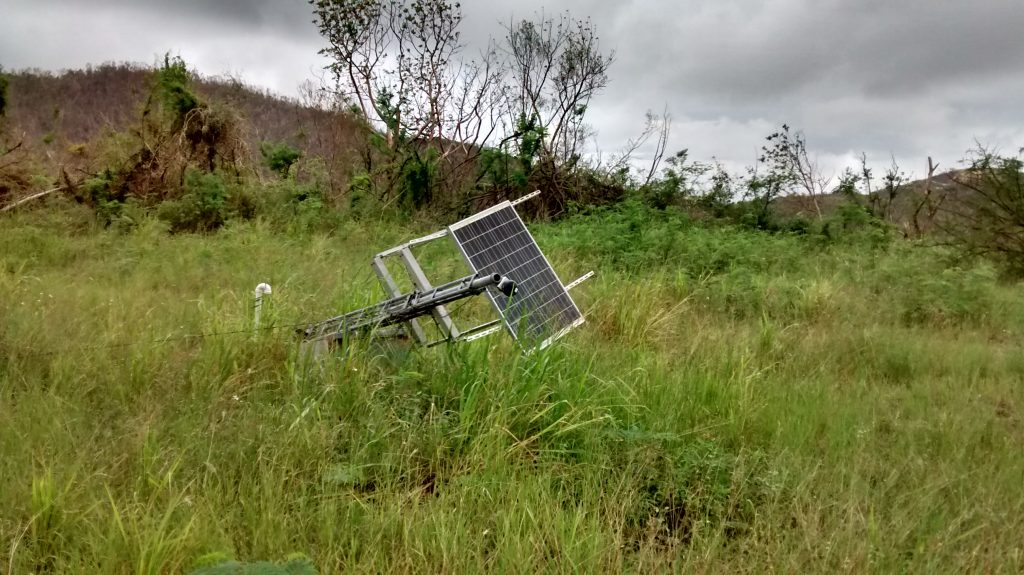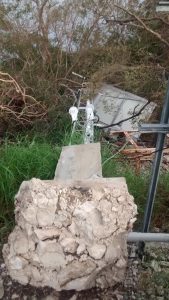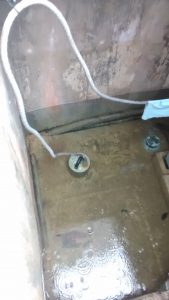12 January 2018–Three months after two hurricanes hit Puerto Rico and the Virgin Islands, the Puerto Rico Seismic Network (PRSN) has rebounded from a complete failure of Puerto Rico’s power and communication systems, with half of the island’s seismic stations operational as of mid-December 2017.
From the earliest days of Hurricane Maria, a Category 5 storm that made landfall in Puerto Rico on September 20, the analysts and staff of PRSN were assessing damage to the network and serving as a vital link in the island’s emergency communications, said Elizabeth Vanacore, a PRSN assistant research professor.

“I have to brag about my guys,” Vanacore said in an interview at the American Geophysical Union Fall Meeting held December 11-15 in New Orleans, Louisiana. “We had analysts who came in the day after the hurricane, driving five hours, and cutting with a machete to get to the network to see when they needed to be at their work shift. We had students that came in to work with us. Our chief analyst, Gisela Báez Sánchez, didn’t even know if she had a house for about a week, but she handled all of our local management.”
Many of Vanacore’s colleagues still lack electricity, “so when I was coming to AGU, I left my house keys at the network, so our analysts and students can use my house to do laundry and take a hot shower,” she said.
At the AGU meeting, Vanacore and her PRSN colleagues discussed the impact of Maria and the Category 5 hurricane Irma on the seismic network capabilities for Puerto Rico and the Virgin Islands—what went wrong, and how PSRN is planning to recover, rebuild and improve the network. The effort is headed by Víctor Huérfano Moreno, PRSN director and an associate professor at the University of Puerto Rico, Mayagüez.
“Total Collapse”
Hurricane Maria brought “the total collapse of the Puerto Rico communications and power infrastructure,” Vanacore said. “We lost everything, including the FEMA [Federal Emergency Management Agency] NAWAS [National Warning System] and our NOAA [National Oceanic and Atmospheric Administration] radio. During the hurricane and in immediate aftermath, we had radio to our local emergency managers, but we could not reach the eastern side of the island. And we had our satellite phone to talk with federal agencies.”
The NAWAS loss was particularly jarring, she noted, since that communication system is supposed to be “hardened”—-all over the U.S., NAWAS is the phone system meant to withstand all disasters, including a nuclear attack.

Island in Lajas / PRSN
With its contingency of operations plan in place, PRSN was able to transfer earthquake monitoring to the National Earthquake Information Center (NEIC) and tsunami warning to the Pacific Tsunami Warning Center (PTWC). The network was asked by PREMA to transmit National Weather Service bulletins and emergency communications for the west side of the island. (The network was unable to communicate with the eastern side of the island due to a downed repeater in the middle of the island.)
For the first time during the hurricane, PRSN took over as the tsunami warning focal point for Puerto Rico on the west side of the island, acting as the central point of contact for tsunami and other coastal hazards. And the network played a vital role in relaying messages during one of the most dramatic episodes on the island after Maria—-the evacuation of the area around the Guajataca Dam near the western towns of Isabela and Quebradillas.
Damage to the Network
Vanacore said the first priority of PRSN after Maria “was to our workers, and our students, to make sure that they were OK, and to wait until it was safe to send people into the field to assess our damage. For the first two weeks after the hurricane, it was not safe because of downed [power] lines and downed trees” and uncertainty about gasoline supplies for vehicles.
Directly after the storm, the network had four seismic stations working, “enough so we could see a major event if it happened, but locating it would require assistance,” Vanacore explained.

When the PRSN teams did make it into the field, they found major failures in the communication towers supporting the network. “We found towers pulled out of the ground, torn in half, and some of our solar panels destroyed,” Vanacore said. The researchers also noted a specific design flaw in the towers that probably contributed to their failure, she said. In many cases, the solar panels powering the towers were attached to the towers themselves, acting as sails that caught the high winds and helped to uproot the structures.
The seismic instruments themselves are contained in concrete vaults buried two to three meters underground and stayed mostly intact, with a few instruments damaged by flooding. As of early December, PRSN has counted eight broadband seismometers and eight accelerometers that need to be replaced.
At the moment, none of the network stations in the Virgin Islands are operational, Vanacore said. “We have yet to get to those stations, because there are still transport issues on those islands, and we have been asked to wait.”
Planning for the Future
As of December 2017, PRSN could detect significant events of magnitude 3.5 or larger across Puerto Rico and the Virgin Islands, but could not detect microseismic events on the eastern side of Puerto Rico. “The stations that are there, we can’t talk to, and they can’t talk to us, so for now we have to go out to retrieve the data to reanalyze events,” Vanacore explained.

The seismologists are seeking ways to diversify their communication providers for internet and phone, and are planning to put 10 Puerto Rico stations on satellite point-to-point communications to make the network more resilient during the next hurricane. They are also exploring redesign options that would separate communication towers and solar panels.
PRSN is working with the U.S. Geological Survey to seek federal funding of some of these upgrades to make the network more resilient. Vanacore said seismologists can help Puerto Rico rebuild its infrastructure—-including its seismic stations–by contacting their congressional representatives and asking them to support federal grants for Puerto Rican recovery. “So far, the support has been incredible from the seismology community.”
